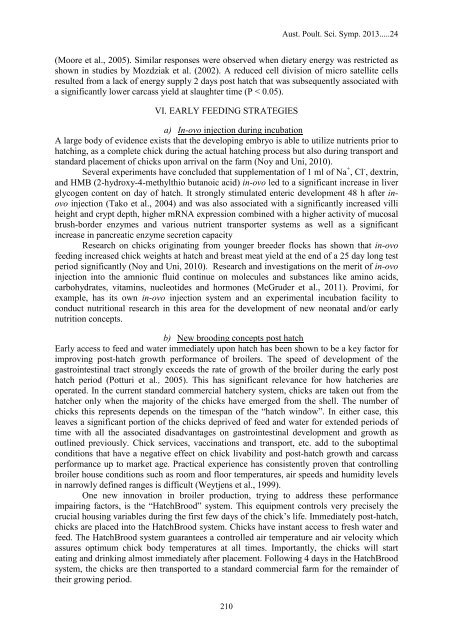APSS 2013 Proceedings - The University of Sydney
APSS 2013 Proceedings - The University of Sydney
APSS 2013 Proceedings - The University of Sydney
You also want an ePaper? Increase the reach of your titles
YUMPU automatically turns print PDFs into web optimized ePapers that Google loves.
Aust. Poult. Sci. Symp. <strong>2013</strong>.....24<br />
(Moore et al., 2005). Similar responses were observed when dietary energy was restricted as<br />
shown in studies by Mozdziak et al. (2002). A reduced cell division <strong>of</strong> micro satellite cells<br />
resulted from a lack <strong>of</strong> energy supply 2 days post hatch that was subsequently associated with<br />
a significantly lower carcass yield at slaughter time (P < 0.05).<br />
VI. EARLY FEEDING STRATEGIES<br />
a) In-ovo injection during incubation<br />
A large body <strong>of</strong> evidence exists that the developing embryo is able to utilize nutrients prior to<br />
hatching, as a complete chick during the actual hatching process but also during transport and<br />
standard placement <strong>of</strong> chicks upon arrival on the farm (Noy and Uni, 2010).<br />
Several experiments have concluded that supplementation <strong>of</strong> 1 ml <strong>of</strong> Na + , Cl - , dextrin,<br />
and HMB (2-hydroxy-4-methylthio butanoic acid) in-ovo led to a significant increase in liver<br />
glycogen content on day <strong>of</strong> hatch. It strongly stimulated enteric development 48 h after inovo<br />
injection (Tako et al., 2004) and was also associated with a significantly increased villi<br />
height and crypt depth, higher mRNA expression combined with a higher activity <strong>of</strong> mucosal<br />
brush-border enzymes and various nutrient transporter systems as well as a significant<br />
increase in pancreatic enzyme secretion capacity<br />
Research on chicks originating from younger breeder flocks has shown that in-ovo<br />
feeding increased chick weights at hatch and breast meat yield at the end <strong>of</strong> a 25 day long test<br />
period significantly (Noy and Uni, 2010). Research and investigations on the merit <strong>of</strong> in-ovo<br />
injection into the amnionic fluid continue on molecules and substances like amino acids,<br />
carbohydrates, vitamins, nucleotides and hormones (McGruder et al., 2011). Provimi, for<br />
example, has its own in-ovo injection system and an experimental incubation facility to<br />
conduct nutritional research in this area for the development <strong>of</strong> new neonatal and/or early<br />
nutrition concepts.<br />
b) New brooding concepts post hatch<br />
Early access to feed and water immediately upon hatch has been shown to be a key factor for<br />
improving post-hatch growth performance <strong>of</strong> broilers. <strong>The</strong> speed <strong>of</strong> development <strong>of</strong> the<br />
gastrointestinal tract strongly exceeds the rate <strong>of</strong> growth <strong>of</strong> the broiler during the early post<br />
hatch period (Potturi et al., 2005). This has significant relevance for how hatcheries are<br />
operated. In the current standard commercial hatchery system, chicks are taken out from the<br />
hatcher only when the majority <strong>of</strong> the chicks have emerged from the shell. <strong>The</strong> number <strong>of</strong><br />
chicks this represents depends on the timespan <strong>of</strong> the “hatch window”. In either case, this<br />
leaves a significant portion <strong>of</strong> the chicks deprived <strong>of</strong> feed and water for extended periods <strong>of</strong><br />
time with all the associated disadvantages on gastrointestinal development and growth as<br />
outlined previously. Chick services, vaccinations and transport, etc. add to the suboptimal<br />
conditions that have a negative effect on chick livability and post-hatch growth and carcass<br />
performance up to market age. Practical experience has consistently proven that controlling<br />
broiler house conditions such as room and floor temperatures, air speeds and humidity levels<br />
in narrowly defined ranges is difficult (Weytjens et al., 1999).<br />
One new innovation in broiler production, trying to address these performance<br />
impairing factors, is the “HatchBrood” system. This equipment controls very precisely the<br />
crucial housing variables during the first few days <strong>of</strong> the chick’s life. Immediately post-hatch,<br />
chicks are placed into the HatchBrood system. Chicks have instant access to fresh water and<br />
feed. <strong>The</strong> HatchBrood system guarantees a controlled air temperature and air velocity which<br />
assures optimum chick body temperatures at all times. Importantly, the chicks will start<br />
eating and drinking almost immediately after placement. Following 4 days in the HatchBrood<br />
system, the chicks are then transported to a standard commercial farm for the remainder <strong>of</strong><br />
their growing period.<br />
210
















